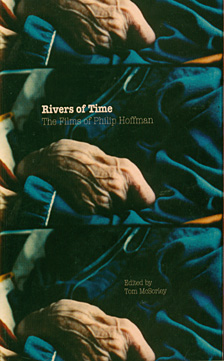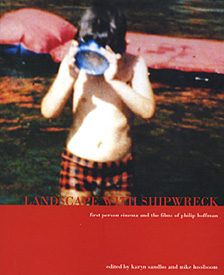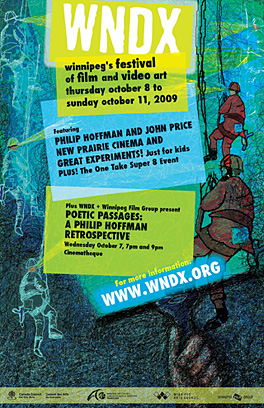by Richard Kerr
Let me begin with a confession: I have known Philip Hoffman for more than thirty years. We used to travel together, play hockey, make pictures. An old friendship demands loyalty and discretion, a respect for the line between the stories only the two of you can share, and those fit for print. Phil is an autobiographer, that is his muse, his stock in trade. His life is his material, and any pulling back the curtains or insider exposé might threaten this project. Rarely has someone’s life and work been so interchangeable. In place of hyper-biography I’ve relied on exchange and process, a terrain as practitioners we are both comfortable with. We wanted to keep it on the lighter side, there’s enough angst in our work after all, and rely on a faux interview dialogue. I wanted to touch on the broad stokes that lay at the heart of Phil’s work and process. More importantly, I wanted to know what he is thinking these days, in order to reflect on the consistencies and changes in his thinking over the years. This dialogue is necessarily incomplete. What is said is important, but what is left unspoken is more important. But that is the way these old friends would have it.
What is your idea of perfect happiness?
It changes daily.
What is your greatest fear?
Hospitals (in Ontario).
Lightning (everywhere else).
What is your greatest extravagance?
400’ loads of Double-X negative.
What is your favourite journey?
Inner. It’s cheap, fast and out of control.
What do you consider the most over rated virtue?
Confidence.
What is your current state of mind?
It changes as I write.
What do you consider your greatest achievement?
Most Gentlemanly Player, Waterloo Siskins—1974.
What do you regard as the lowest depth of misery?
Imprisoned in your own life.
What quality do you most like in a man?
Emotion.
What quality do you most like in a woman?
Muscle.
How would you like to die?
At home.
What is your motto?
It changes.
August 31, 2000
Hi Richard,
It seemed as Monday morning rolled around there were just too many pressures with J’s family visit outside of Montreal, and the little girl’s needs (you know all about that, kids are new for me). Anyway, it seemed too much. I’m very moved that you are contributing to this book because in my mind, you are my brother. Our drifting apart was quite painful for me, so your gestures to reconnect are touching. I want to do the same and am really sorry our meeting didn’t work out.
Phil
In the mid-1970s, when Phil was gearing up the grand project of autobiography as his life’s work, the times were less than encouraging. Especially for a middle class white male. And there was a considerable canon of experimentalists who had already forged significant works of cinematic autobiography. Marie Menken, Jonas Mekas, Stan Brakhage and Robert Frank come to mind, but you can make your own list. This received history can be heavy for a young maker trying to sort it all out.
The mid-70s also marked a sea change from modernism to post-modernism with its libraries of cultural theory and prescriptions of political correctness. It was uncool, if not politically dangerous, to reflect on the self. These pressures of influence could easily lead a young filmmaker away from their muse. But Phil’s clear thinking and thoroughness, his wait and watch style and deliberateness, separated him from the rest of us. Day to day discipline created his body of work. As Yogi Berra put it, “You can observe a lot just by watching.”
Memories that won’t be made into films
Teenaged Phil alone in his room, listening to Dylan while family life reverberates around him.
Walking on water wasn’t built in a day. —Jack Kerouac.
Phil always looked like his Father. He was the youngest, with three triplet sisters, but was always the man around the house, possessed of an early quiet confidence and responsibility.
There is no decisive moment. It’s got to be created. I’ve got to do everything to make it happen in front of the lens. —Robert Frank
Phil was small, wiry, strong and tough. He got bigger every year. He was a natural athlete, competitive but clean, and he never backed down. He was a crafty pool player, a game he sharpened in the basement with hispoolshark uncle Wally. The darkroom was next door.
I’ll play it first and tell you what is later. —Miles Davis
Things happened fast once we built our first darkroom. Enterprise and imagination. Dylan sings, “You go your way, and I’ll go mine.”
No poet, no artist of any art has complete meaning alone. His significance, his appreciation, is the appreciation of his relation to the dead poets and artists. —T.S. Eliot
Young Phil at his lake a.k.a. On the Pond. Another classic setting in the young man’s life. I always imagined he did his big thinking there. The river served a different purpose…
Ideas are one thing and what happens is another. —John Cage
On the banks of the Saugeen River, sixteen year-old Phil guts a brook trout. Every year the same scene on a different river: Quebec, Nova Scotia, Newfoundland, Alberta… but never Saskatchewan. I lived in Regina for fifteen years. Final note about fishing: I suspect Phil enjoyed fishing by himself, as opposed to groups. Too much bonding in a boat will drive a young man to the river.
It is a mistake for an artist to speak too often about their job. It releases the tension needed for work. —Jemina Knowles
Phil Hoffman’s father is proud of his son. I saw that look in his eye thirty years ago, on the (backyard) pond. I saw it again fifteen years later at the Toronto debut of passing through/torn formations. I hope to see that look one more time before I go.
I never heard much about Phil’s days in his father’s meat packing plant, they were overshadowed by his father’s stories which were fantastical. His roots were German, hardworking, filled with personal sacrifice and just rewards. But it was always clear that the son would go his own way. Solo is vertical. The Hoffman team has the most refined sense of father and son I can imagine.
I always say keep a diary and someday it will keep you. —Mae West
There was always cold beer, reefer and a loaded camera on the road trips. But Phil was the only one who could fix a flat tire in the middle of the night.
I write for myself and strangers… The strangers, dear reader, are an afterthought. —Gertrude Stein
The more Phil travels, the more verbal he becomes. He may be the best life observer I know. We took some important (R+D) trips together. In 1976 we drove to the Allan Ginsberg archives via Ginsberg’s New Yorkapartment, a good story, but I’ve forgotten too much of it to tell properly. Phil would be able to though. Four years later we drove east to find Robert Frank in Mabou, chronicled in The Road Ended at the Beach. We took a sci-fi type journey to Love Canal. Countless rages into the night that I can barely remember. Once again, Phil’s memory is better than mine … of the details at least.
I know with certainty that a man’s work is nothing but the longing to recover, through the detours of art, the two or three simple and great images which gained access to his heart. —Albert Camus, 1960
In the restless years between high school and university, Phil looks for the way through. We stay tuned in. One day, he showed up at Sheridan College. Things happened fast again. We are living our movies. Here are the first signs of Phil as an image and sound collector, so organized and methodical. His obsessive work patterns were already established, a life of consistent film creation lay ahead.
All art is a more or less oblique confession. All artists, if they are to survive, are forced to tell the whole story, to vomit up the anguish. —James Baldwin, 1961
Before photography: many nights out with Phil where nothing is said but much seen. After photography even less is said, but pictures are taken, sound recorded. We are pecking, hunting and gathering. Process is process, but where are the negatives? It was never about copyright, but archive. Memory counts. Phil would have taught me that.
Part of our work is to make what is strange more familiar. The vomit’s always kept hidden away like idle chatter at a funeral.
Marian comes to my wedding in Toronto. It becomes a late afternoon lawn party. As a jet passes overhead, I say it’s Phil on his way to Holland and Greenaway’s zoo. We smile.
We teach together at Sheridan College, huge hours, the beginnings of our second careers. We are dragged into our first academic mutiny, always learning on the job. Today we’re still teaching, keepers of some sort of flame.
There are a few industry freelance ventures, promos for Women’s College Hospital. I direct, Phil shoots, the piece wins awards, good start! Kevin Sullivan’s first effort Krieghoff which is really Phil’s story, maybe one of his best. I often wonder if he tells his students about his freelance days. There was a Parachute Club video called Sexual Intelligence, good work if you could get it.
The moment you cheat for the sake of beauty, you know you’re an artist. —Max Jacob, 1922
I moved to Saskatchewan to take a teaching job after Phil turned them down. Phil referred me, I made a cold call, and once again it all worked out. Phil and I weren’t seeing much of each other by then, both trying to look after our separate lives.
Personal history (autobiography) is an effort to find salvation, to make one’s own experience come out right. —Alfred Kazin
In Saskatchewan I sit with my young family glued to CBC watching the Genies. Phil is up for Best Documentary with ?O,Zoo! He wears his comfortable brown cardigan. He has a winner’s look.
Autobiography provides insurance against oblivion. But without publicity, oblivion endures. I believe that all careers end in failure, that each of us manages a certain coherence manifest in a particular work, granted by personality, hard work and luck. But after that moment our later years are spent in decline. If we are fortunate, we are able to do so with dignity. Life is diamond shaped. In the beginning, opportunities expand, later they contract. Unfortunately, none of us knows where the widest point of the diamond resides until we’ve already passed it. The big bang theory of careers? This contracting might not be as negative as it appears because one may retreat from career into home life, perhaps to take care of elders or make gardens. But perhaps there are several diamonds expanding and contracting at different times in your life. Like those party hats you get as a kid, excited to find as you unfold each hat, that one is connected to the other, and you discover that they go on and on, forever.
 LANDSCAPE WITH SHIPWRECK is a book that acts upon the reader with an uncanny ability to engage both the emotions and the intellect. Quotations from diverse sources are liberally sprinkled throughout thebook, point and counterpoint, making a sort of contrapuntal music. Lifting you up, confirming, lulling, exciting and sometimes terrorizing you. So many times I had to stop and pluck a quote from this rich veinand write it into my journal for safekeeping. What Hoolboom and Sandlos say in their introduction is true:”By reading this book, you risk making this story your own.”
LANDSCAPE WITH SHIPWRECK is a book that acts upon the reader with an uncanny ability to engage both the emotions and the intellect. Quotations from diverse sources are liberally sprinkled throughout thebook, point and counterpoint, making a sort of contrapuntal music. Lifting you up, confirming, lulling, exciting and sometimes terrorizing you. So many times I had to stop and pluck a quote from this rich veinand write it into my journal for safekeeping. What Hoolboom and Sandlos say in their introduction is true:”By reading this book, you risk making this story your own.”
 Philip Hoffman has been making personal documentary films for over twenty years. He has devoted his life to examining the narrow aperture each of us uses to bring our own experience into focus. As many of the writers in this volume will attest, telling personal stories is dangerous work.
Philip Hoffman has been making personal documentary films for over twenty years. He has devoted his life to examining the narrow aperture each of us uses to bring our own experience into focus. As many of the writers in this volume will attest, telling personal stories is dangerous work.
